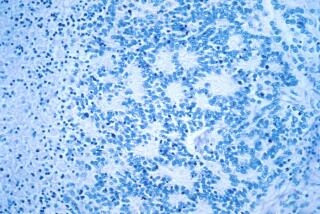Experimental HIV Treatment Launched
- Share via
Around 2 on Thursday afternoon at Childrens Hospital Los Angeles, a 13-year-old girl infected with the virus that causes AIDS became the first child to undergo experimental gene therapy to combat the disease.
That is when registered nurse Beth Haden inserted an IV line into the girl’s arm, turned the stopcock, and let flow into her bloodstream half a liter of warm fluid containing genetically engineered cells from her own bone marrow.
Medical scientists extracted those cells Monday from her pelvic bone and then endowed them with genetic material intended to hinder the growth of the AIDS virus, HIV. The girl became infected as an infant from an HIV-contaminated blood transfusion, said Dr. Donal Kohn, a pediatric immunologist who conducted the study with Dr. Joseph Church, an AIDS specialist.
Her parents “understand that they are participating in research, and that there is only a remote possibility that it will help their child,” Kohn said. “But I think emotionally they’re hoping she’ll be lucky.”
(The family asked for anonymity and declined interview requests.)
Kohn said that the experiment posed little risk to the girl, who is healthy and attends school, and that the worst was over--the general anesthesia she received during the bone marrow extraction. There was only a slight chance that she would have an allergic reaction to the genetically engineered cells, he said. The girl is the first of five children with HIV that the Childrens Hospital scientists are planning to study.
Essentially, the strategy of the gene therapy is to confuse the virus at a crucial stage in its reproduction. The engineered marrow cells harbor a bogus shred of virus genetic material that the virus uses to put itself together.
If HIV gets into those engineered cells and tries to replicate, it may end up using the genetic decoy instead of the real thing. That will jam up the virus assembly line, and, the researchers speculate, curb the infection.
Before experimenting on the girl, the scientists tested the techniques on human cells in test tubes, showing that marrow cells endowed with the decoy genetic material were protected from HIV infection. Kohn said that the experiment is supposed to determine if the technique is feasible in people and whether, for instance, the engineered cells will even take root in the girl’s bone marrow. The scientists will sample her blood for a variety of tests each month for two years.
The experiment comes at a time when HIV drugs have gained attention for extending many patients’ lives. The girl, Church said, has been taking such medications, including the so-called protease inhibitor drugs, and will continue doing so.
But the much-touted success of the drug therapies shouldn’t make people complacent, he said. “The drugs don’t work for everyone,” he said. “We need to look at every possible avenue of altering the natural history of this virus. Gene therapy is just one strategy.”
A hospital spokesman said the girl was resting comfortably.






